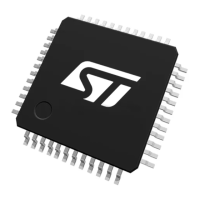Universal synchonous receiver transmitter (USART) RM0444
1026/1390 RM0444 Rev 5
33.5.13 USART LIN (local interconnection network) mode
This section is relevant only when LIN mode is supported. Refer to Section 33.4: USART
implementation on page 1000.
The LIN mode is selected by setting the LINEN bit in the USART_CR2 register. In LIN
mode, the following bits must be kept cleared:
• CLKEN in the USART_CR2 register,
• STOP[1:0], SCEN, HDSEL and IREN in the USART_CR3 register.
LIN transmission
The procedure described in Section 33.5.4 has to be applied for LIN Master transmission. It
must be the same as for normal USART transmission with the following differences:
• Clear the M bit to configure 8-bit word length.
• Set the LINEN bit to enter LIN mode. In this case, setting the SBKRQ bit sends 13 ‘0
bits as a break character. Then two bits of value ‘1 are sent to enable the next start
detection.
LIN reception
When LIN mode is enabled, the break detection circuit is activated. The detection is totally
independent from the normal USART receiver. A break can be detected whenever it occurs,
during Idle state or during a frame.
When the receiver is enabled (RE = 1 in USART_CR1), the circuit looks at the RX input for
a start signal. The method for detecting start bits is the same when searching break
characters or data. After a start bit has been detected, the circuit samples the next bits
exactly like for the data (on the 8th, 9th and 10th samples). If 10 (when the LBDL = 0 in
USART_CR2) or 11 (when LBDL = 1 in USART_CR2) consecutive bits are detected as ‘0,
and are followed by a delimiter character, the LBDF flag is set in USART_ISR. If the LBDIE
bit = 1, an interrupt is generated. Before validating the break, the delimiter is checked for as
it signifies that the RX line has returned to a high level.
If a ‘1 is sampled before the 10 or 11 have occurred, the break detection circuit cancels the
current detection and searches for a start bit again.
If the LIN mode is disabled (LINEN = 0), the receiver continues working as normal USART,
without taking into account the break detection.
If the LIN mode is enabled (LINEN = 1), as soon as a framing error occurs (i.e. stop bit
detected at ‘0, which is the case for any break frame), the receiver stops until the break
detection circuit receives either a ‘1, if the break word was not complete, or a delimiter
character if a break has been detected.
The behavior of the break detector state machine and the break flag is shown on the
Figure 324: Break detection in LIN mode (11-bit break length - LBDL bit is set) on
page 1027.
Examples of break frames are given on Figure 325: Break detection in LIN mode vs.
Framing error detection on page 1028.

